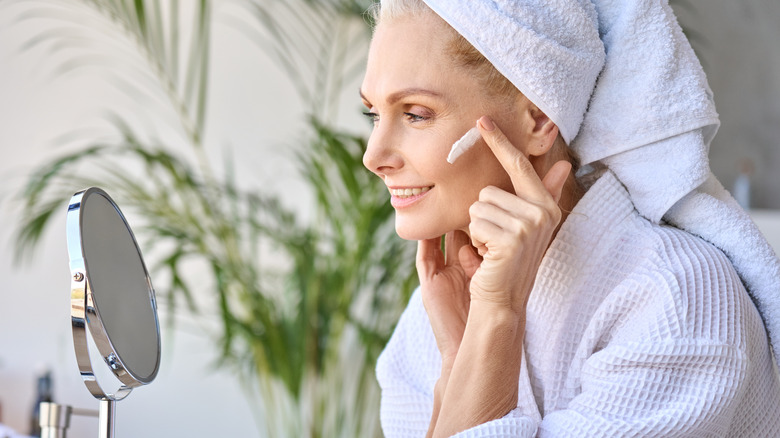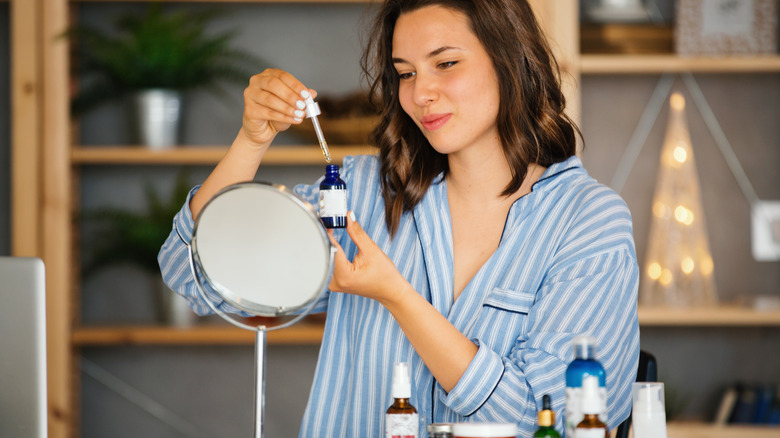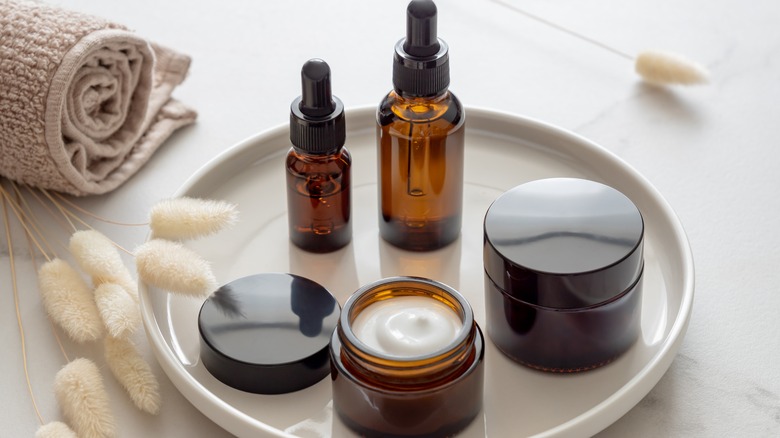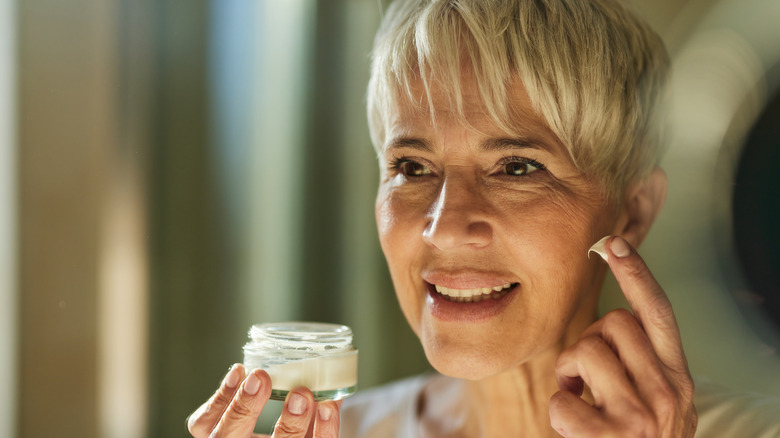Skincare Ingredient-Mixing Mistakes That Can Cause Damage To Your Skin
We may receive a commission on purchases made from links.
Many of us have seen skincare products that work wonders on the faces of TikTokers. The before and after close-ups are hard to ignore. So, in our quest for the perfect skin, we jump on the skincare products wagon, adding new ingredients to our daily beauty care regime. We buy products that we see online, products our friends swear by, and products influencers make sure we need. However, when it comes to caring for our skin, the old mantra "less is more" couldn't be more accurate.
While many products are excellent on their own, combining a plethora of ingredients in the hopes of achieving a silky smooth, glowy face can be detrimental to our skin's health. For example, using two types of exfoliants on the same day can result in irritation, especially for combination skin (per Healthline). The truth of the matter is that some ingredients just don't get along.
"You want ingredients that will mix and not separate like oil and water in order to get an even distribution of the mixture on your skin. Mixing ingredients can provide additive effects to your skin," Dr. Deborah Yu, a cosmetic surgeon, told Dermastore. "If ingredients do not necessarily 'match,' you should be aware that you could have a less than optimal result." So, before choosing your moisturizers, eye creams, serums, and skincare products, pay attention to these ingredients that don't work well together.
Retinol and salicylic acid
Retinol is a common ingredient in skincare products. It is a type of vitamin A that is primarily used to treat acne. Retinol increases skin cell production and works as an anti-aging agent, minimizing fine lines and reducing wrinkles. Additionally, retinol exfoliates the skin by unclogging pores and encourages collagen production, resulting in a fresh and youthful appearance. Side effects of retinol include irritation, dryness, redness, and eczema or acne flare-ups (via Cleveland Clinic).
Salicylic acid is a beta-hydroxy acid that is also used in many products for acne treatment, specifically targeting blackheads and whiteheads. It works by exfoliating the skin and keeping your pores clear. Potential side effects of salicylic acid include itching, tingling, stinging sensation on the skin, and peeling (per Healthline).
While it may seem that a combination of both retinol and salicylic acid would lead to faster, more visible results when treating acne, it could actually make the condition worse. "You do not want to use two potent ingredients that have the same effect on your skin ... Retinol and salicylic acid can each cause skin irritation when used on their own," Dr. Yu explained to Dermstore. "Combining these items might make your skin feel dry and sensitive, especially to light." If you are unsure which product is best for your skin and would like to give them both a try, use them interchangeably every other day.
AHAs, BHAs, and vitamin C
Alpha hydroxy acid (AHA) and beta hydroxy acid (BHA) are skin exfoliants used to decrease inflammation on the skin, reduce rosacea, and combat acne (via Healthline). They are gentle exfoliants that improve skin texture by removing dead skin cells, unclogging pores, and evening out skin tone. While AHAs and BHAs fulfill a similar purpose, there is a fundamental difference between the two, according to the Cosmetic Laser Center of Irvine. AHAs, derived from sugarcane, milk, or fruit, are water-soluble, whereas BHAs, derived from sources like willow bark and sugar beets, are oil-soluble. BHAs penetrate deeper into the pores and help loosen and remove dead skin cells. Using AHAs and BHAs can leave your skin feeling refreshed, hydrated, and smooth.
Vitamin C is noteworthy for its brightening effects. Vitamin C serums and creams contain antioxidants that help clear up and brighten the skin, often used in melasma and hyperpigmentation treatments. "Vitamin C ... helps prevent the forming of free radicals, which go on to break down collagen and elastin," Thomas Jefferson University clinical associate professor and board-certified dermatologist Dr. Nazanin Saedi told Everyday Health.
As fantastic as these products sound, certain ingredients should not be mixed with AHAs and BHAs. As dermatologist Dr. Tsippora Shainhouse shared with Dermstore, vitamin C is one of these ingredients. It turns out the acids can alter vitamin C's pH factor, rendering it ineffective.
Vitamin C and retinol
To recap, vitamin C is an antioxidant agent that boosts collagen production, resulting in glowing, youthful skin. Retinol is an anti-aging ingredient that exfoliates the skin and promotes cell production. While these two ingredients address different skincare concerns, they should not be used together due to the optimal environment each requires to function properly.
"Vitamin C is a tough ingredient to formulate with because it's most effective in an acidic pH environment," dermatologist Dr. Brooke Sikora clarified while speaking to Everyday Health. "Retinol works in a higher (more alkaline) pH. If using them together, they won't work optimally."
Fortunately, this issue can be resolved by using retinol as part of your nighttime routine and vitamin C during the day. Sikora pointed out that retinol increases the skin's photosensitivity, making it more susceptible to sunburns. Vitamin C, as an antioxidant, works better in the daylight hours, protecting skin from pollutants and dirt (always followed by a high SPF cream!)
Vitamin C and niacinamide
Niacinamide is the water-soluble version of vitamin B3. "[Niacinamide has] notable dermatological benefits, including regulating excess sebum production (helpful for oil control), reducing acne breakouts, and minimizing the appearance of pores," board-certified dermatologist and founder of Brown Skin Derm Dr. Adeline Kikam told CNN. Moreover, niacinamide has anti-inflammatory qualities and reduces redness. It improves the skin's barrier, retaining moisture and helping visibly dehydrated and tired skin while minimizing the appearance of fine lines. Additionally, niacinamide is a known ally in the battle against hyperpigmentation and dark spots.
While vitamin C and niacinamide are both great ingredients on their own, they aren't the best of friends when it comes to working simultaneously together. "Both are very common antioxidants used in a variety of skincare products, but they should not be used one right after the other," board-certified dermatologist Dr. Shari Marchbein explained to InStyle. "Their potency is significantly diminished when used together unless the application is spaced by at least 10 minutes between each serum."
If you are inclined to add some vitamin C to your niacinamide, it's best to reconsider. Instead, you can try using each ingredient on its own, only applying the second after Dr. Marchbein's suggested 10-minute waiting period. This way, you can enjoy the full benefits of the two by layering them instead of mixing them.
Soap-based cleanser and vitamin C
According to a study published in the Journal of Clinical and Aesthetic Dermatology in 2017, vitamin C has been linked to the reduction of free radicals produced by UV exposure that cause the skin to age. However, vitamin C's effectiveness depends on maintaining low pH levels on the skin. So, how low should the pH levels be? Let's break down the pH scale to clarify.
The pH scale ranges from 1 to 14. A pH lower than 6 is considered acidic, and a pH greater than 8 is considered alkaline. A pH of 7 is neutral (fun fact: this is the pH level of water). You want your skin's pH level to fall in the lower-end acidic range, between 4.7 and 5.75. However, soap-based cleansers can have a pH level as high as 9 to 10 (via Simple Skincare). While not at the extreme end of the alkaline range, using a soap-based cleanser can increase your skin's natural pH, interfering with vitamin C's efficacy.
Therefore, before you apply your vitamin C serum, make sure to use a cleanser that aligns with the optimal pH levels. Washing your face with a soap-based cleanser may render your vitamin C treatment ineffective and potentially expose your skin to the damaging effects of free radicals.





